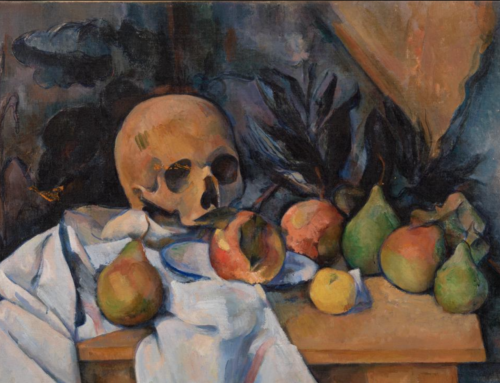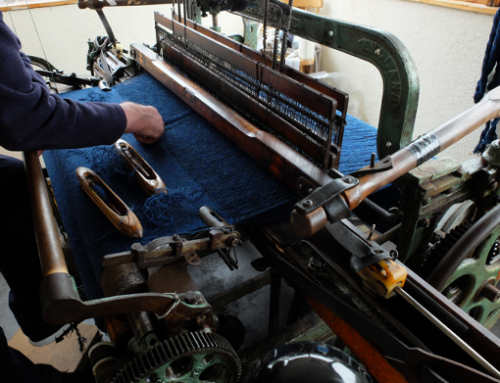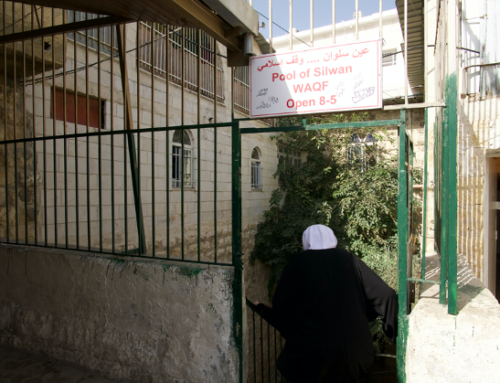We enter the kumina circle seeking fellowship, communication, and guidance, shuffling counter-clockwise to the heartbeat and tack-a-tack rhythm of the drums toward a transcendence of Western logics of personhood and time, whether Enlightenment or Marxist. Kumina is part of what Sylvia Wynter (1970) calls the “indigenization” of African descendants in the so-called New World: the processes through which Black people humanized the landscape of plantation-based slave production by peopling it with their gods and spirits.
Kumina emerged from the practices of indentured laborers who were brought to Jamaica from the Kongo region of Central Africa after the abolition of slavery in 1838. Many of them had been enslaved by Spanish or Portuguese traffickers, and then recaptured by British ships patrolling the Atlantic after Britain abolished the slave trade in 1807. They would have been subsequently taken to either Sierra Leone or St. Helena (where they would have met the many Maroons who had also been settled there decades before) (Chopra 2018), and then sent from there to the New World as part of the African indentured labor schemes of the post-emancipation period (Warner-Lewis 1977; Schuler 1980).
What these sojourners would have encountered in Jamaica has been called a “myal complex,” an African-based religious structure oriented toward healing and deliverance from the ontological degradations of slavery. Myalism was identified (and feared) by planters as early as the 1760s (Long 1774) as a worldview that conceptualized individuals as possessing multiple souls, and in which the dead were seen to be part of the living world. Zora Neale Hurston was one of the earliest ethnographic observers of these phenomena. In Tell My Horse, the ethnography that emerged from her field trips to Jamaica and Haiti in 1936, she wrote “there is no death. Activities are merely changed from one condition to the other” (1990, 43, italics in original). Here, Hurston is acknowledging that there is no fixed referent for presence, in either temporal or material terms. The present is imbued with the past and the future through the embodied presences of ancestors and generations to come. In myal, the body mediates time and lineage, a process that is not entirely dissimilar from the ways an ethnographer mediates the contexts and questions imbuing her site.
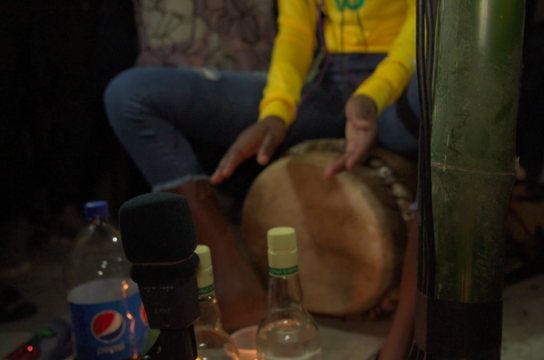
Astride a Kumina drum during Tambufest 2018, screenshot from video taken by Leniqueca A. Welcome and used with permission.
For practitioners, kumina is born in you; it is an inheritance, and it defines a lineage. Within a kumina ceremony, the counter-clockwise dancing, driven by the drums and marked by the singing, is meant to invite myal, a complex of being and knowing that heralds the return of ancestors and a surrender to spirit. In myal, the feet become heavy, the head “grows,” consciousness wanes, the community of dancers rallies to care for the possessed individual. Ushered in is a gnosis both old and new, one in which souls are not contained by bodies, the dead are not dead, the past is not past, and the here and now is also the there and then—as well as the possibility of something else to come.
It is myal that creates the conditions for healing and well-being, individually and collectively, today and in this world. It thus instantiates what Wynter has identified as “radical difference,” a difference grounded in the gods, beliefs, and modes of storytelling that accompanied Black people on slave ships, to build new worlds (Wynter 1977). In the world of kumina, progressive developmentalist teleologies are eschewed, binaries of body and soul are destabilized, and a conception of Africanness as “exponential” (Stewart 2005)—as encompassing both the particularities of ethnicity and a pan-Africanist sensibility—is advanced.
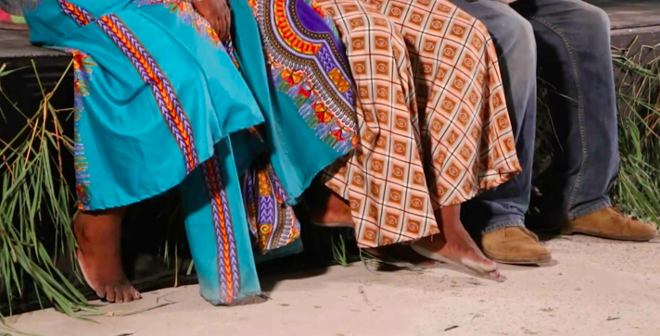
Dancers sitting on the edge of the stage during Tambufest 2019, screenshot from video edited by Farrah Rahaman and used with permission.
Where early American (or American-trained) observers of kumina reflected the acculturation and functionalist frameworks of many mid-20th century anthropologists (Moore 1953 (and see Warner-Lewis’s 2016 critique of his research design and questions); Simpson 1970; Seaga 1969). Later (and local) scholars came to understand kumina as evidence of the ontological and epistemological continuity of central African notions and practices of being within Jamaica (Wynter 1970; Warner-Lewis 1977, 2003; Brathwaite 1978; Bilby and Bunseki 1983; Ryman 1984; Stewart 2005). In these texts, we are given lists of ki-Kongo words as they are used among kumina practitioners; Bakongo and Bantu cosmologies are outlined; parallels are drawn between central African prohibitions against the eating of salt and the washing of clothes in the river with those that endure among Jamaicans; and conceptual continuities are outlined in terms of possession, ancestral veneration, and herbalism.
These interventions emerged from a wider effort during the 1960s and 1970s among West Indian scholars to reject the notion that acculturation was the primary conceptual frame through which to understand Caribbean societies. They argued instead that the dominant European sector, often absent, did not provide a cultural and social scaffolding to which dominated Africans had to acclimatize, but that Afro-West Indians, in maintaining, reconstructing, and transforming their own cultural practices (especially those having to do with land use and religious expression) underwent a cultural process of indigenization that rooted them in the New World, rejecting colonial logics of personhood and production. For these scholars, and for those who followed them, it was the African heritage embedded within Caribbean cultures that should be seen as the primary site of cultural creativity. Understanding the ontologies of kumina therefore became part of their present, which necessitated a more robust decolonial intellectual and political praxis (Wynter 1970; Brathwaite 1971).
These are descriptive as well as analytic texts, coalescing around the overarching principle that the body is unbounded. This principle is rooted within relationships between the living and the ancestors, relationships brought into view through drumming, dance, and myal. For these scholars, what is critical is that the ritual practice of kumina provides evidence for and access to modes of thinking and being in community that are not tethered to liberal, Western models, but that instead instantiate what Paul Christopher Johnson has called a “bodily technology of history making” (2014, 6-7). This history, of course is iterative, and like ancestral presences, linked to the problems of the moment, the community, the individual within the community, while also being transmitted bodily. What the body knows, what the body remembers, and what the body communicates are modes of presence grounded in relation.
When contemporary practitioners describe what it feels like when myal comes on, they say, “You can feel it move inna you, feel your body a rock, a more powerful energy.” Or, “Sometimes I can feel it coming on and I can resist it, like stop dancing, do certain things, cut it off. But when I go deep, I know nothing. When I come back, I dirty. Mud up.” Such observations reflect what Roberto Strongman has identified as a kind of transcorporeality distinctive to Afro-diasporic communities but reflective of broader African conceptualizations of personhood, in which the human soul is “multiple, removable, and external to the body that functions as its receptacle” (2019, 2). The real tragedy of imperialism and slavery, Strongman argues, was not that it positioned Africans as primitive, backward and soulless, but that its discourse of interiority closed off their “philosophical corporeal openness while at the same time legislatively prohibiting precisely those religious rituals of trance possession that render black bodies inhabited or soulful” (Strongman 2019, 4).

Mother and son on stage during Tambufest 2022, screenshot from video taken by Laurie Lambert and used with permission.
We are still contending with this past that is not past, with the afterlives and after-presences of social theory grounded in the historical-ideological and onto-epistemological production of whiteness, maleness, and Europeanness as the apex of humanity, the epitome not only of transparency and universality, but also of determination and causality (Ferreira da Silva 2007, 2017). But what if anthropology, like kumina and other ancestral traditions, was more oriented toward unboundedness, toward relational (perhaps spiral) conceptions of space, time, presence, and personhood? What if our engagements were understood as ancestral ones, ones in which those who came before us, and even our former selves, continued to intervene in the lives of our interlocutors (for better or for worse)? In what ways would an attunement to this possibility transform our commitments to, and conceptualizations of, our presence and presents?
References
Bilby, Kenneth M. and Fu-Kiau Kia Bunseki. 1983. “Kumina: A Kongo-Based Tradition in the New World.” Originally published in Cahiers du CEDAF 8(4):1-114, but here pp. 473-528 in A Reader in African-Jamaican Music, Dance, and Religion, Eds. Markus Coester and Wolfgang Bender, Kingston, Jamaica: Ian Randle Press, 2015.
Brathwaite, Edward Kamau. 1978. “Kumina: The Spirit of African Survival.” Jamaica Journal 12(2):44-63.
Chopra, Ruma. 2018. Almost Home: Maroons between Slavery and Freedom in Jamaica, Nova Scotia, and Sierra Leone. New Haven: Yale University Press.
Ferreira da Silva, Denise. 2017. “1 (life) ÷ 0 (blackness) = ∞ – ∞ or ∞/∞: On Matter Beyond the Equation of Value.” E-flux Journal #79, https://www.e-flux.com/journal/79/94686/1-life-0-blackness-or-on-matter-beyond-the-equation-of-value/.
Ferreira da Silva, Denise. 2007. Toward a Global Idea of Race. Minneapolis: University of Minnesota Press.
Hurston, Zora Neale. 1990[1938]. Tell My Horse: Voodoo and Life in Haiti and Jamaica. New York: Harper and Row.
Johnson, Paul Christopher. Ed. 2014. “Introduction: Spirits and Things in the Making of the Afro-Atlantic World.” In Spirited Things: The Work of ‘Possession’ in Afro-Atlantic Religions, Ed. Johnson, pp. 1-22. Chicago: University of Chicago Press.
Long, Edward. 1774. The History of Jamaica, 3 Volumes. London: T. Lowndes.
Moore, Joseph. 1953. Religion of the Jamaican Negroes: A Study of Afro-Jamaican Acculturation. Ph.D. Dissertation, Northwestern University.
Schuler, Monica. 1980.“Alas, Alas, Kongo”: A Social History of Indentured African Immigration into Jamaica, 1841-1865. Baltimore: The Johns Hopkins University Press.
Ryman, Cheryl. 1984. “Kumina: Stability and Change.” ACIJ Research Review 1:81-128.
Seaga, Edward. 1969. “Revival Cults in Jamaica.” Jamaica Journal 3(2):3-13.
Simpson, George Eaton 1970. Religious Cults of the Caribbean: Trinidad, Jamaica, and Haiti. Rio Piedras: Institute of Caribbean Studies, UPR.
Stewart, Dianne. 2005. Three Eyes for the Journey: African Dimensions of the Jamaican Religious Experience. Oxford: Oxford University Press.
Strongman, Roberto. 2019. Queering Black Atlantic Religions: Transcorporeality in Candomblé, Santería, and Vodou. Durham: Duke University Press.
Warner-Lewis, Maureen. 2016. “Kumina Fieldwork: Findings and Revisions.” Jamaica Journal 36(3): 22-31.
Warner-Lewis, Maureen. 2003. Central Africa in the Caribbean: Transcending Time, Transforming Cultures. Mona: University of the West Indies Press.
Warner-Lewis, Maureen. 1977. The Nkuyu: Spirit Messengers of the Kumina. Mona: Savacou Publications.
Wynter, Sylvia. 1977. “‘We Know Where We Are From:’ The Politics of Black Culture from Myal to Marley.” Paper presented at the joint meetings of the African Studies Association and the Latin American Studies Association, Houston, TX, November 1977.
Wynter, Sylvia. 1970. “Jonkonnu in Jamaica: Toward the Interpretation of Folk Dance as a Cultural Process.” Jamaica Journal 4(2):34-48.
Deborah A. Thomas is the R. Jean Brownlee Professor of Anthropology, and the Director of the Center for Experimental Ethnography at the University of Pennsylvania. She is the author of Political Life in the Wake of the Plantation, Exceptional Violence, and Modern Blackness, and co-director of the documentary films Bad Friday and Four Days in May. She is currently the co-chair of the American Anthropological Association’s Commission on the Ethical Treatment of Human Remains.
Cite As: Thomas, Deborah A. 2024. “Afterpresence: The Unbounded Body”, In “Back to the Present” edited by Timothy P.A. Cooper, Michael Edwards & Nikita Simpson, American Ethnologist website, January 26 2024, [https://americanethnologist.org/online-content/collections/back-to-the-present/afterpresence-the-unbounded-body/]
